Introduction:
Potato salad is a popular dish often enjoyed at picnics, barbecues, and family gatherings. However, its ingredients, which typically include mayonnaise, eggs, and potatoes, can be prone to spoilage if not stored properly. Understanding how long potato salad lasts in the refrigerator, the factors that affect its shelf life, and the signs of spoilage can help you enjoy this dish safely. This comprehensive guide offers detailed insights into the storage, handling, and preservation of potato salad.
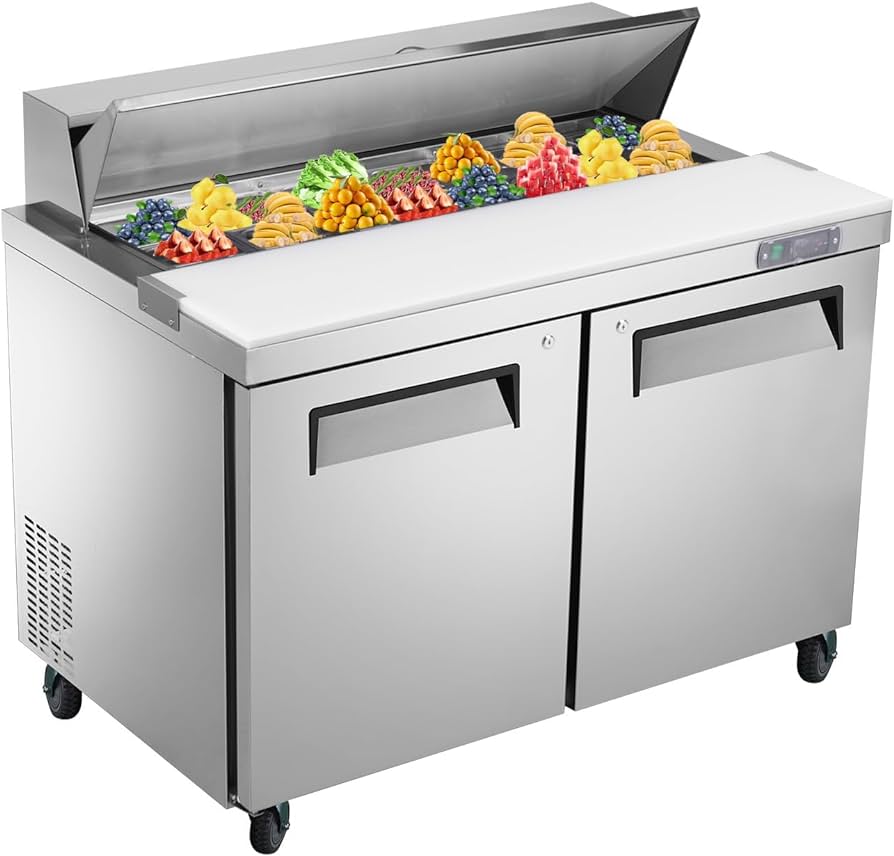
How Long Will Potato Salad Last in the Refrigerator:
What Factors Affect Its Shelf Life?
Preparation and Ingredients:
How Do Ingredients Affect the Shelf Life of Potato Salad?
The ingredients used in potato salad can significantly influence its shelf life. Different recipes and preparation methods result in varying longevity.
Common Ingredients:
Mayonnaise-Based Potato Salad: Traditional potato salad often includes mayonnaise, which is perishable and prone to spoilage. Commercial mayonnaise contains preservatives, extending its shelf life, but homemade mayonnaise can spoil faster.
Egg-Based Potato Salad: Some potato salad recipes include hard-boiled eggs. Eggs increase the risk of bacterial growth if the salad is not stored correctly.
Vinegar-Based Dressing: Potato salad with a vinegar-based dressing tends to last longer than its mayonnaise-based counterpart due to the acidic nature of vinegar, which can inhibit bacterial growth.
Vegetable Additions: Ingredients like celery, onions, and pickles can also affect the shelf life. Fresh produce can introduce additional moisture and bacteria, influencing how long the salad remains fresh.
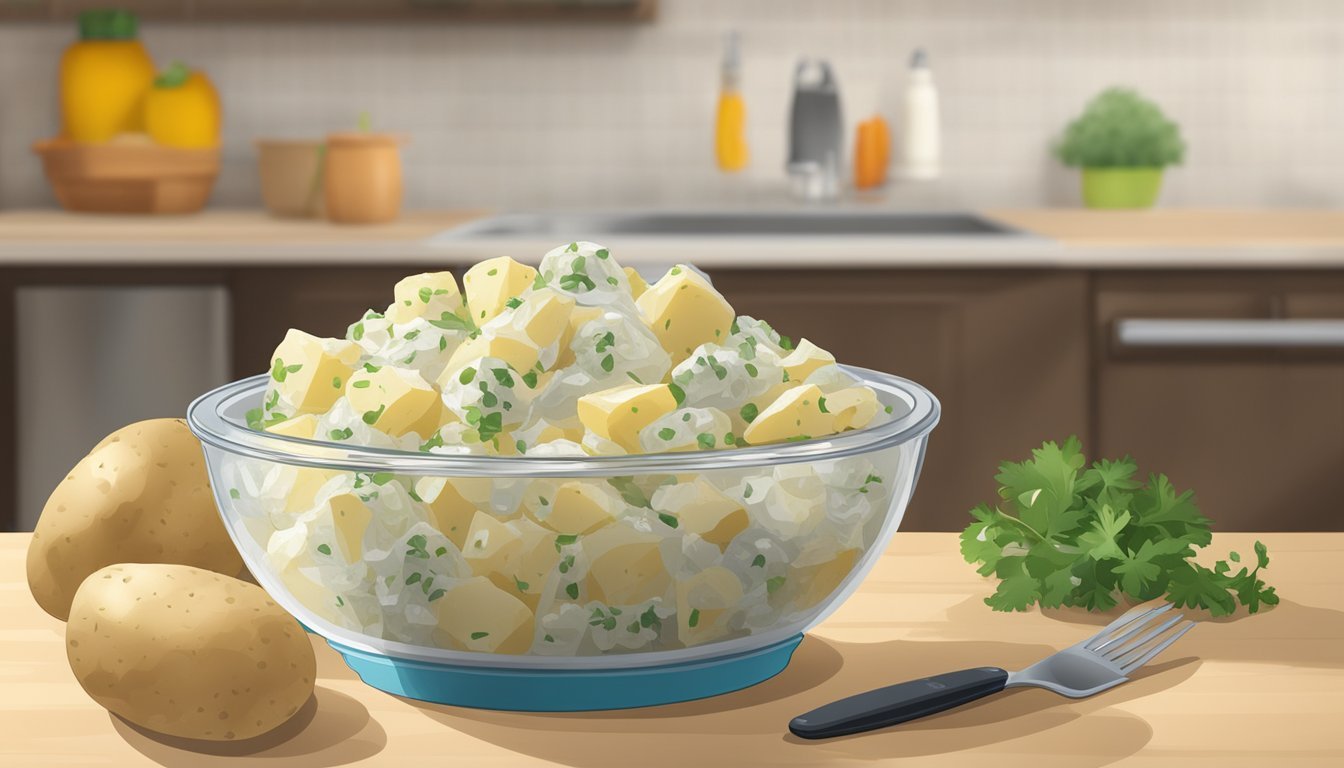
Preparation Method:
Sanitization: Using clean utensils, bowls, and hands during preparation reduce the risk of contamination. Ensuring that all ingredients are fresh also contributes to a longer shelf life.
Cooking Potatoes: Cook potatoes thoroughly and cool them rapidly to minimize the growth of bacteria. Undercooked or improperly cooled potatoes can spoil more quickly.
Storage Conditions:
How Should Potato Salad Be Stored in the Refrigerator?
Proper storage conditions are crucial for maintaining the freshness and safety of potato salad.
Refrigeration:
Temperature Control: Store potato salad in the refrigerator at or below 40°F (4°C). Keeping the salad at a consistently low temperature inhibits bacterial growth.
Storage Container: Use an airtight container to store potato salad. This prevents exposure to air and contaminants, helping to maintain its quality and flavor.
Portion Management:
Serve Immediately: When serving potato salad at gatherings, keep portions small and replenish as needed to avoid having large quantities sit out at room temperature.
Quick Refrigeration: After serving, return any unused portion to the refrigerator within two hours to minimize the risk of spoilage.
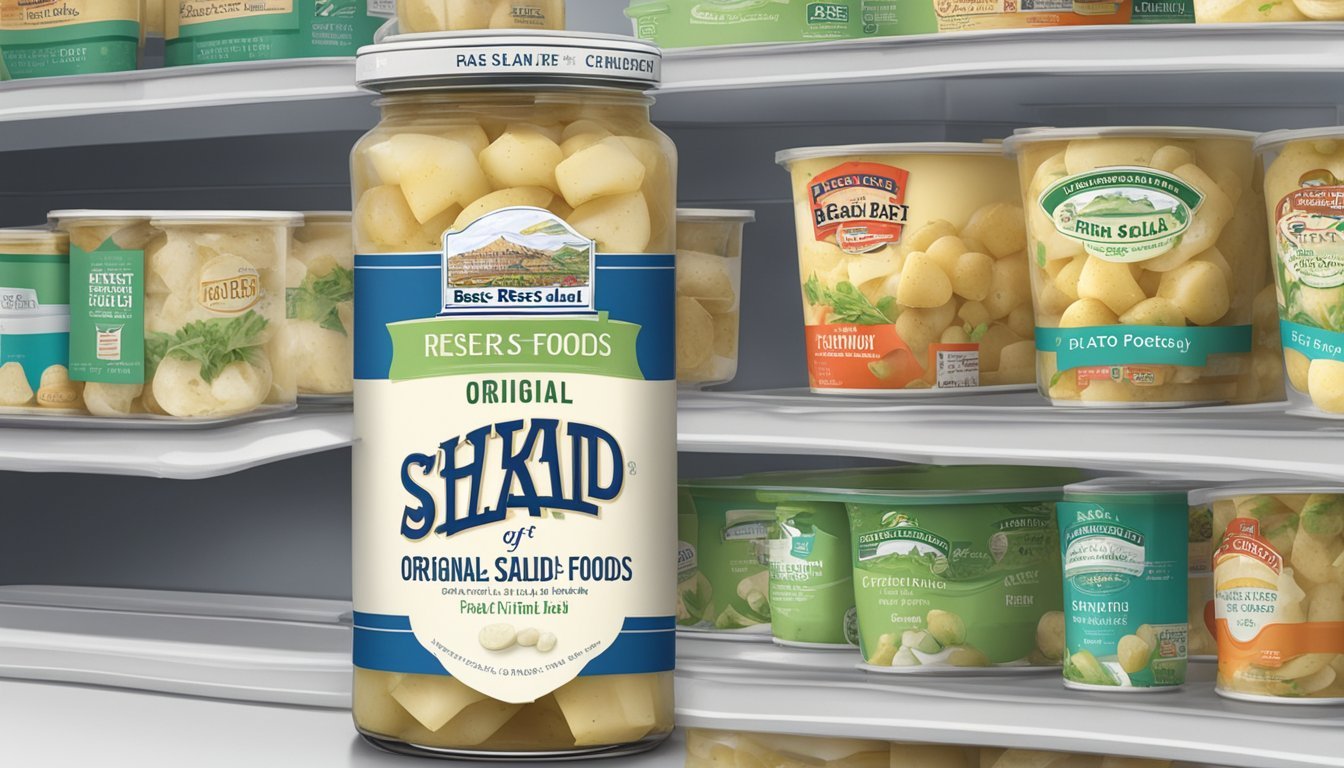
Shelf Life Duration:
How Long Can You Safely Store Potato Salad in the Refrigerator?
The duration for which potato salad can be safely stored in the refrigerator depends on various factors.
General Guidelines:
Store-Bought Salad: Store-bought potato salad typically contains preservatives and can last longer. Check the “use by” date on the packaging and store it in the refrigerator. Generally, it lasts up to 5-7 days unopened. Once opened, consume it within 3-4 days.
Homemade Salad: Homemade potato salad usually lasts 3-5 days in the refrigerator. The lack of preservatives makes it more prone to spoilage.
Vinegar vs. Mayonnaise:
Vinegar-Based: Potato salad with a vinegar-based dressing might last slightly longer due to vinegar’s preservative properties, remaining fresh up to 5-7 days.
Mayonnaise-Based: Mayonnaise-based potato salad has a shorter shelf life and should be consumed within 3-5 days.
Signs of Spoilage:
What Indicators Suggest Potato Salad Has Gone Bad?
Recognizing the signs of spoilage can help prevent foodborne illnesses and ensure you consume potato salad safely.
Visual Cues:
Color Change: Discoloration, such as a pink, yellow, or green hue developing on the salad, can indicate spoilage. Fresh potato salad should retain its original colors.
Mold Growth: Any visible mold on the potato salad is a clear sign that it has spoiled and should be discarded immediately.
Texture Changes:
Sliminess: If the potato salad develops a slimy texture, it’s a strong indicator of bacterial growth and spoilage.
Dryness or Separation: Separation of the dressing or an unusually dry texture can also point to spoilage, particularly if the salad was initially creamy.
Odor:
Sour or Off Smell: Fresh potato salad has a mild, pleasant aroma. If it emits a sour, rancid, or otherwise off smell, it has likely spoiled.
Taste:
Unusual Flavor: If the potato salad tastes off or has an unusual flavor different from when it was freshly made, discard it.
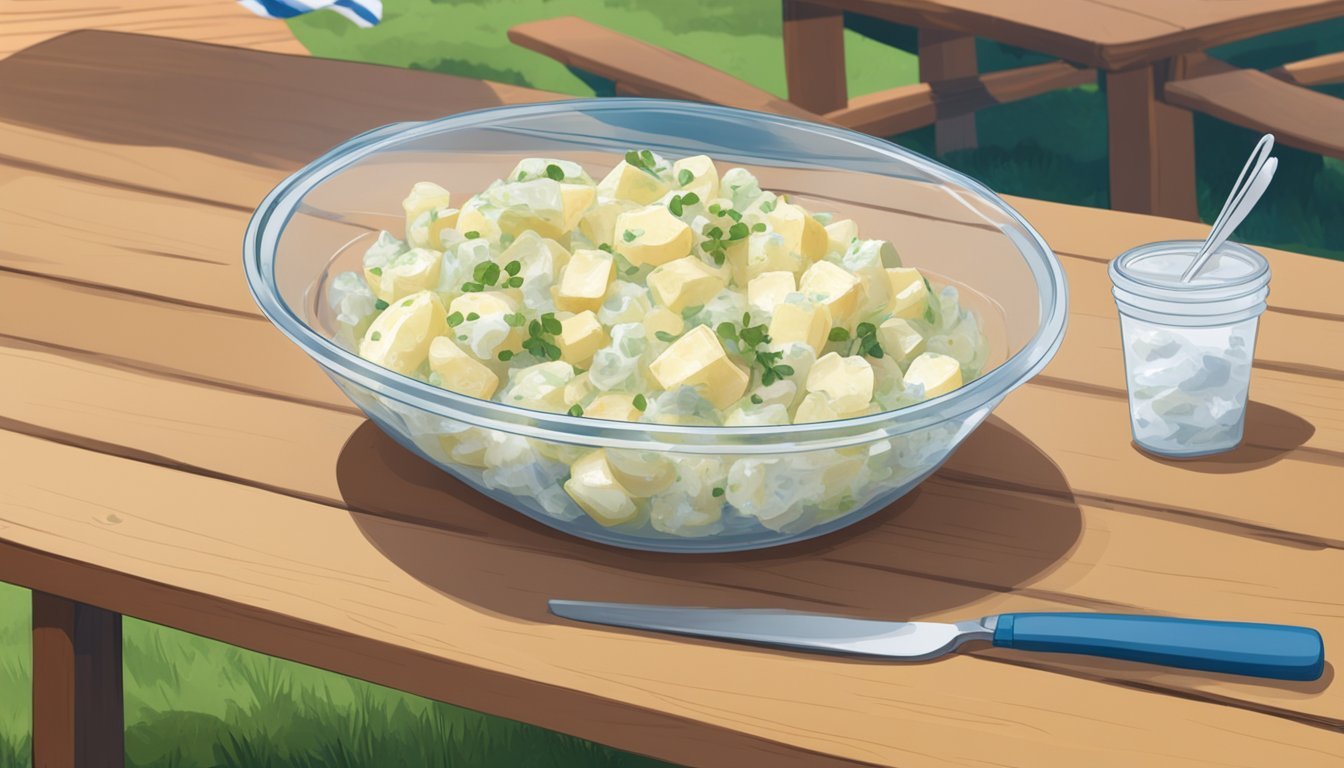
Extending Shelf Life:
What Methods Can Prolong the Freshness of Potato Salad?
Certain techniques can help extend the shelf life of potato salad, preserving its taste and quality.
Cooling Technique:
Rapid Cooling: Cool cooked potatoes quickly by spreading them out on a baking sheet before mixing them into the salad. Rapid cooling reduces the risk of bacterial growth.
Chilling Ingredients: Chill all ingredients, including mayonnaise and boiled eggs, before mixing. This helps keep the salad at a lower temperature, enhancing its longevity.
Storage Solutions:
Smaller Portions: Store potato salad in smaller, separate containers to minimize exposure each time you take a portion. This practice reduces the risk of contamination.
Vacuum Sealing: Consider using vacuum-sealed bags or containers to prolong freshness by reducing air exposure.
Additives:
Vinegar Addition: Incorporate a small amount of vinegar or lemon juice into mayonnaise-based potato salad for its preservative qualities. These acids can help inhibit bacterial growth.
Preservatives: If preserving a larger quantity for future consumption, consider freezable preservatives or natural preservatives like citric acid, though freezing may alter texture.
Special Considerations:
How Do Different Environments Affect Potato Salad Shelf Life?
Environmental factors such as temperature and humidity levels can impact the shelf life of potato salad.
Outdoor Events:
Temperature Control: When serving potato salad outdoors, use coolers or ice packs to maintain a safe temperature. Keeping the salad cold helps prevent rapid spoilage.
Serving Time: Limit the time potato salad spends outside the refrigerator. Aim to keep it out for no more than two hours, or one hour in hot weather.
Refrigerator Conditions:
Humidity Levels: Maintain moderate humidity levels in your refrigerator. Excessive moisture can facilitate bacterial growth, while too little can dry out the salad.
Consistent Temperature: Avoid frequent opening of the refrigerator, which can cause temperature fluctuations that may affect the shelf life of perishable items like potato salad.
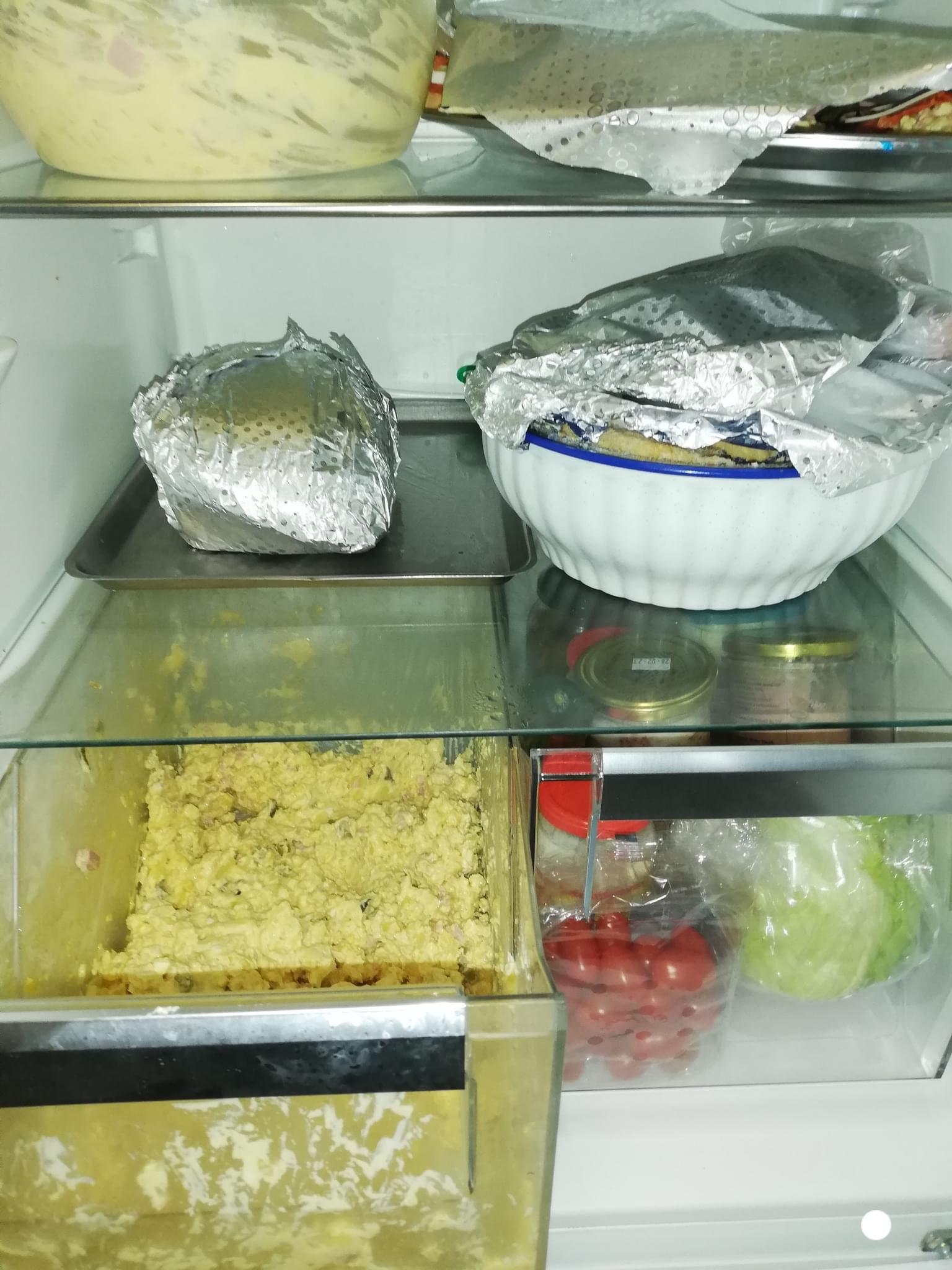
Freezing Potato Salad:
Is It a Viable Option for Extending Shelf Life?
Freezing can extend the shelf life of many foods, but potato salad is not always an ideal candidate due to its ingredients.
Texture Changes:
Mayonnaise Breakdown: Freezing can cause mayonnaise to separate and break down, leading to an unappealing texture when thawed.
Potato Texture: Potatoes can become grainy or mushy after freezing and thawing, compromising the quality of the salad.
Alternative Approaches:
Partial Freezing: If you need to freeze potato salad, consider freezing only the cooked potatoes and adding fresh dressing and other ingredients after thawing.
Pre-Freezing Test: Try freezing a small portion first to see how it holds up before committing to freezing the entire batch.
Conclusion
Knowing how long potato salad lasts in the refrigerator and applying proper storage techniques ensures that you can enjoy this dish safely and without waste. From understanding the impact of different ingredients to recognizing signs of spoilage and employing effective storage methods, you can maximize the freshness and quality of your potato salad. By following these guidelines, you can savor your homemade or store-bought potato salad with peace of mind, confident in its safety and taste.
